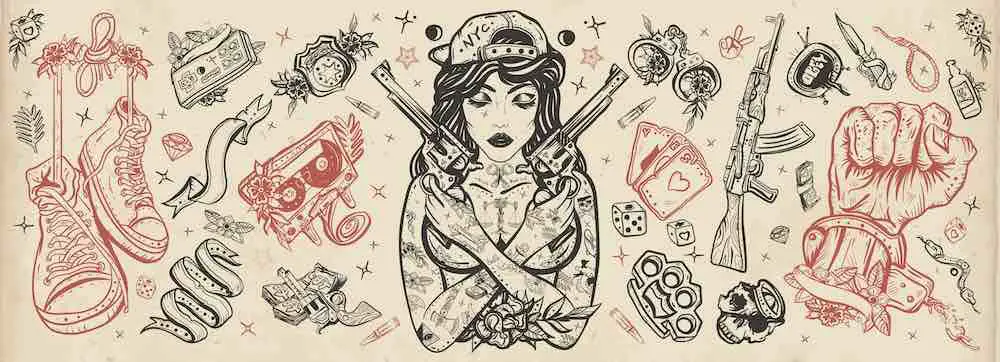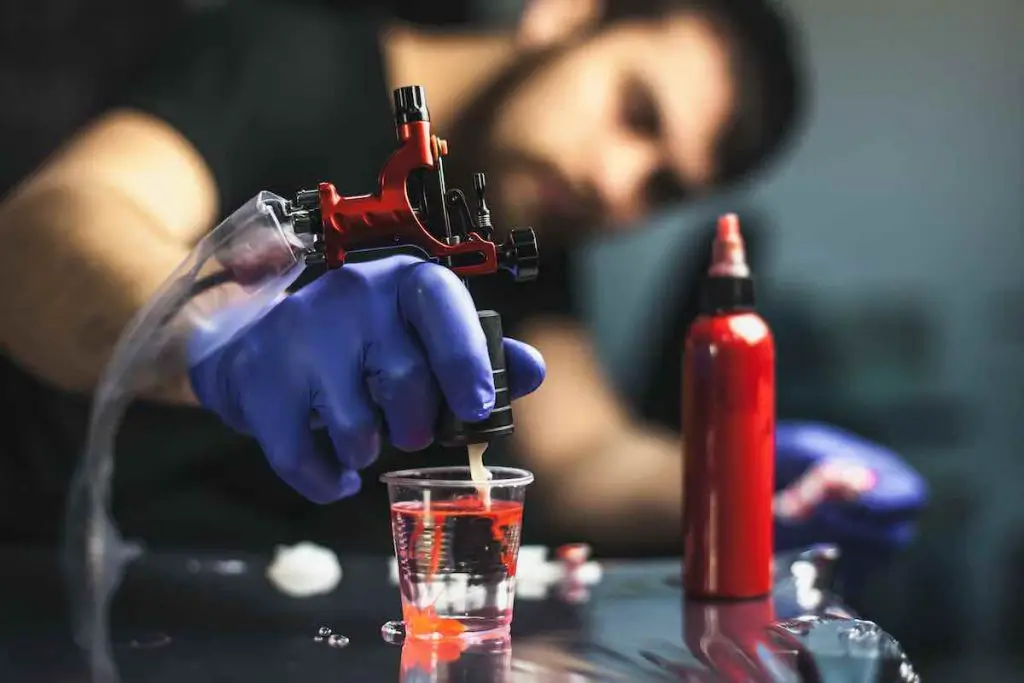The Yakuza tattoo style has a rich history and deep cultural significance in Japan. The Yakuza, a collection of notorious Japanese mafia groups, have been associated with this unique style of tattoos since at least the 19th century. Steeped in symbolism and often featuring intricate, large-scale designs, these tattoos continue to be popular today not just among Yakuza members but also among tattoo enthusiasts around the world.

Japanese Yakuza tattoo imagery is deeply rooted in cultural traditions and folklore, often displaying characters and creatures from mythology, religious symbols, and elements of nature. The designs can be either colorful or rendered in simple black, covering an individual’s entire body or just a specific part. The intricate details and precise techniques required make this style of tattooing a craft that demands a high level of skill from tattoo artists.
Key Takeaways
- Yakuza tattoo style originates from the Japanese mafia groups and has a rich cultural background
- These tattoos feature intricate designs rooted in mythology, religion, and nature
- The craft of creating Yakuza tattoos requires high levels of skill from tattoo artists
History of Yakuza Tattoo Style
Edo Period
During the Edo Period, irezumi (traditional Japanese tattoos) were highly popular in Japan. This art form had its roots in local folklore and Japanese tradition. At this time, tattoos were seen as a symbol of status, often worn by members of the han (Japanese feudal domains) and ri (traditional Japanese measurements of length).
The Yakuza, a notorious Japanese mafia group, adopted the irezumi tattoo style during this period. As criminals, they were drawn to the art form for its powerful symbolism and intricate designs. Yakuza tattoos became synonymous with their criminal lifestyle, setting them apart from other gangs in Japan.
Meiji Period
In the Meiji Period, the Japanese government attempted to modernize the country and its culture. As a result, tattoos were deemed a negative aspect of Japan’s past and outlawed. However, this only increased their popularity among the Yakuza, who continued to wear them as a sign of defiance and a dedication to their criminal lifestyles.
Yakuza tattoos during this period were marked by intricate, full-body designs that often included elements of Japanese tradition and folklore, such as dragons, koi fish, and samurai warriors. The extensive use of shading and incorporating vibrant colors within each design provided the tattoos with a sense of depth and movement.
In addition to their aesthetic appeal, yakuza tattoos served as a form of identification within the criminal community. Members would wear these tattoos as a sign of loyalty, commitment, and their willingness to endure great pain for the sake of their clan.
Today, the Yakuza tattoo style remains an emblematic part of Japanese tattoo culture. While no longer solely associated with the criminal underworld, these tattoos still carry a sense of strength, resilience, and dedication to a cause that holds true for both Yakuza members and nonmembers alike.
Yakuza Tattoo Imagery and Symbolism
Dragons
In Yakuza tattoos, dragons often symbolize courage, strength, and wisdom. They are considered protectors of the human race and represent clarity and endurance. Japanese dragons also provide a sense of knowledge and illumination.
Tigers
Tigers are known for their strength, bravery, and protection. In Yakuza tattoo designs, they embody power and serve as symbols of courage and inner strength. The majestic nature of the tiger distinguishes it as a powerful Yakuza tattoo symbol.
Koi Fish
Koi fish are symbolic of perseverance, luck, and prosperity. In Yakuza tattoos, koi fish are often depicted swimming upstream, representing determination and the ability to overcome obstacles. They also symbolize the ability to change one’s fortune through hard work and dedication.
Phoenix
The phoenix represents rebirth, renewal, and transformation. In Yakuza tattoos, the phoenix symbolizes the ability to overcome adversity and rise above challenges. This powerful mythological creature is known for its connection to fire and immortality, making it a popular Yakuza tattoo choice for those seeking rebirth or a new beginning.
Samurai
Samurai tattoos represent loyalty, courage, and martial prowess. A symbol of the traditional Japanese warrior, samurai tattoos embody the virtues of bushido, the warrior code. Yakuza members often gravitate toward samurai imagery as a way to showcase their commitment to loyalty, bravery, and strong moral principles.
Hannya
Hannya tattoos depict a Japanese demon mask associated with heartbreak and jealousy. In Yakuza tattoo designs, the hannya is a symbol of the struggle between love and hatred. It can also represent wisdom, as the hannya mask was traditionally worn by monks when punishing evil spirits.
Snakes
Snakes hold a range of symbolic meanings in Yakuza tattoos. They represent wisdom, protection, and rebirth. The snake’s flexibility and resilience make it a powerful symbol in Yakuza culture, reflecting the adaptability needed to survive in a dangerous world.
Cherry Blossoms
Cherry blossoms are a popular Yakuza tattoo symbol due to their association with beauty, transience, and the fleeting nature of life. Commonly seen in Japanese art, cherry blossoms remind us of the fleeting beauty of our existence and emphasize the need to appreciate and embrace the present.
Peonies
Peonies symbolize fortune, prosperity, and love. In Yakuza tattoos, peonies are often used to convey a sense of wealth and abundance. They also represent feminine beauty and balance, showcasing the harmony between toughness and tenderness. Their bold colors and striking designs make them a popular choice for Yakuza tattoo art.
Colors and Meanings in Yakuza Tattoos
Yakuza tattoos are famous for their vibrant colors, each holding a symbolic meaning. In this section, we will discuss the meanings of various colors in Yakuza tattoos and their relevance to specific tattoo designs.
Red
Red is a powerful color symbolizing passion, love, and strength. In Yakuza tattoos, red may be used to represent a person’s warrior spirit or portray strong emotions. Red is often seen in dragon tattoo designs, symbolizing fury and determination.
Black
Black represents protection, power, and mystery. In Yakuza tattoos, black can be found in designs portraying strength and authority. A black dragon tattoo is associated with wisdom and enlightenment, while a black phoenix tattoo represents resilience and rebirth.
Blue
Blue signifies calmness, wisdom, and loyalty. In Yakuza tattoos, blue is often used to represent inner peace, spirituality, and tranquility. Blue dragon tattoos are tender, human-like, and generous, whereas blue phoenix tattoos connote an understanding, composed demeanor.
Yellow
Yellow is associated with dignity, warmth, and joy. Yakuza tattoos that incorporate yellow often embody pride and a sense of nobility. Yellow dragon tattoos symbolize dignity and partnership, making them popular choices for those looking to convey their commitment to a cause or group.
White
White represents purity, innocence, and spirituality. White is not commonly used as a primary color in Yakuza tattoos, but it may be used as an accent or highlight to other colors, especially in phoenix tattoo designs. A white phoenix is a symbol of renewal and rebirth, illustrating a person’s transformation.
Green
Green is synonymous with nature, growth, and harmony. Green dragon tattoos in Yakuza art symbolize a connection to nature, while a green phoenix tattoo embodies healing and restoration. The use of green in Yakuza tattoos can express a person’s affinity for nature and the environment.
Gold
Gold symbolizes wealth, prosperity, and success. In Yakuza tattoos, gold is often associated with virtues and confidence. A gold dragon tattoo represents a mixture of virtues and strengths, making it a popular choice for those looking to embody a combination of qualities.
Pink
Pink symbolizes femininity, love, and innocence. Though not as common in Yakuza tattoos, pink can be used in designs to express a softer, more nurturing side. A pink dragon tattoo may be chosen to represent a nurturing, irate nature, balancing fierce power with affection and care.
Japanese Tattoo Techniques
Tebori
Tebori is the traditional Japanese hand-poking tattoo technique that has been used for centuries in creating irezumi tattoos, including Yakuza tattoo designs. This technique uses a wooden or metal handle with a group of needles attached to one end. The artist dips the needles in ink and manually inserts them into the skin, creating the tattoo design. The use of Tebori results in a distinct look, characterized by bold lines and rich colors. The technique requires a high level of skill and patience, as the process is often slower than using a modern tattoo machine.
Another advantage of the Tebori method is that it allows for greater control over the depth of the ink, often leading to better healing and longevity of the tattoo. However, it is essential to choose an experienced Tebori artist, as the technique requires expert knowledge and skill to be done safely and correctly.
Shading and Detail
Shading and detail are essential aspects of Yakuza tattoo designs and irezumi style in general. Proper shading can create a sense of depth, while intricate details bring the design to life. For Yakuza tattoos, shading and detail are particularly important, as they often feature complex imagery and symbolism.
A common shading technique in Japanese tattooing is the use of gradients with varying ink tones. This can be achieved by adjusting the size and number of needles used, as well as the pressure applied to the skin. A skilled tattoo artist can create subtle gradations in color or smoothly transition from solid black to lighter shades using the Tebori technique.
Detail is another critical aspect of Yakuza tattoo designs. These tattoos often include intricate scenes, characters, or creatures, drawn from Japanese mythology, historical events, or nature. A high level of craftsmanship is essential to capture these details accurately. This can sometimes take many sessions to complete, as the tattoo artist needs to ensure that each element is rendered with precision.
Traditional Yakuza Tattoo Culture and Themes
The Yakuza are notorious Japanese mafia groups with a rich history dating back to at least the 19th century. They have played a significant role in shaping Japanese tattoo culture, with their intricate Yakuza tattoos becoming synonymous with their identity and criminal lifestyle. These full-body tattoos, collectively known as “irezumi,” are extensive, detailed, brightly colored, and often feature traditional Japanese themes.
Within the Yakuza culture, tattoos have served as a mark of commitment and loyalty to the gang. Yakuza members often get tattooed to showcase their affiliation and distinguish themselves from other gangs. Traditional Yakuza tattoos are characterized by their size, boldness, and the unique themes that illustrate the individual’s beliefs, values, and personal history.
Common themes in Yakuza tattoos include dragons, tigers, koi fish, and mythological creatures. These designs carry symbolic meanings, such as strength, courage, and perseverance. Additionally, there are traditional Japanese motifs like cherry blossoms, lotus flowers, and intricate waves that are often incorporated into Yakuza ink.
It is important to note that getting a Yakuza tattoo is a lengthy and painful process. Traditional Japanese tattooing methods involve manually inserting ink into the skin using a special handheld device with needles. This technique, called “tebori,” requires a skilled tattoo artist and may take months or even years to complete a full-body tattoo.
In Japanese culture, tattoos have long been associated with criminality, and this remains true in the case of Yakuza tattoos. Society often perceives individuals sporting extensive, elaborately detailed tattoos as likely having ties to the underworld. As a result, wearing such ink can come with stigmas and an increased likelihood of confrontation with authority figures.
Today, the Yakuza tattoo style has gained popularity beyond the borders of Japan and the criminal underworld. Many artists and tattoo enthusiasts appreciate the skill, dedication, and cultural significance behind the traditional Yakuza ink.
Modern Yakuza Tattoos and Western Influence
The Yakuza tattoo style, also known as Irezumi, has evolved over the years and assimilated various elements of Western tattoo art. Traditional Yakuza tattoos used to consist mainly of intricate, full-body designs that served as a symbol of loyalty and courage within the mafia group. However, contemporary Yakuza tattoos have evolved to include a mixture of both traditional and modern designs.
Western influences have brought new ideas and styles into the world of Japanese tattooing. The use of bold lines, shading, and more detailed imagery in contemporary Yakuza tattoos can be attributed to the influence of Western tattoo artists. Furthermore, the rise of social media and global travel has facilitated the exchange of tattoo culture between East and West. This cultural exchange has led to a blending of unique elements from both traditions, resulting in innovative, hybrid designs.
In addition to traditional Japanese imagery like dragons, koi fish, and cherry blossoms, modern Yakuza tattoos now incorporate motifs from popular Western tattoo styles, such as tribal patterns and realistic portraits. The adoption of new themes, techniques, and materials has enhanced the artistic possibilities within the Yakuza tattoo style, making it more appealing to people outside of the mafia group.
However, it is important to note that Yakuza tattoos still largely remain within the realm of the criminal underworld in Japan. While they may be admired from a purely aesthetic standpoint, they continue to hold a significant symbolic weight for those who bear them. For Yakuza members, these tattoos represent commitment, solidarity, and often a way of atoning for past misdeeds.
Today, even though the Yakuza tattoo style has integrated Western influences and become more diverse, it hasn’t entirely lost its roots in Japanese culture and tradition. Contemporary designs still maintain a strong connection to the motifs, aesthetics, and values intrinsic to the Yakuza way of life. Consequentially, the Yakuza tattoo style remains a powerful emblem of the rich cultural history behind the infamous Japanese mafia group.
Pain and Experience of Getting a Yakuza Tattoo
Yakuza tattoos, known as irezumi in Japanese, are intricate and often cover the entire body. They are a symbol of commitment and endurance, as the process of getting these tattoos is said to be incredibly painful. The Yakuza believe that experiencing more pain while getting a tattoo demonstrates a higher dedication to the group, which is why you often see full-body tattoos on Yakuza members.
The irezumi process utilizes a traditional method of hand-poking the ink beneath the skin using a special tool called a “nara,” which consists of a wooden or metal handle and a bundle of needles attached to it. This method is slower and more painful than modern tattooing techniques that use tattoo machines. The process can take months or even years to complete, depending on the complexity and size of the tattoo.
As part of the Yakuza culture, getting a tattoo may involve a ritualistic atmosphere. Members may have spectators present to witness their dedication and endurance during the painful tattooing sessions. This practice adds to the intensity of the experience and reinforces the bond among gang members.
It is important to note that the pain of getting a Yakuza tattoo is often perceived as a rite of passage, testing the individual’s loyalty and commitment to the organization. The final result, a full-body suit of intricate, detailed, and bold designs, reflects personal sacrifice and pride in their choice to become a part of the Yakuza.
Frequently Asked Questions
What is the significance of Yakuza tattoos?
Yakuza tattoos, also known as Irezumi, hold deep cultural and symbolic meaning for their members. It shows their commitment, loyalty, and dedication to the group. Tattoos are a form of art and identity for the Yakuza, marking them as part of a unique brotherhood and often reflecting their personal beliefs or achievements within the organization.
What are some common motifs in Yakuza tattoo designs?
Some common motifs in Yakuza tattoo designs include dragons, tigers, koi fish, and mythical creatures like the phoenix. Other designs may feature Japanese folklore figures, such as samurais, geishas, or demons, and elements like cherry blossoms, waves, and wind. These motifs often have deep symbolic meaning, representing strength, protection, bravery, and other values cherished by the Yakuza.
How does the Yakuza tattooing process differ from other methods?
The traditional Yakuza tattooing process, called tebori, involves using a long, thin rod made of wood or metal with a set of needles attached to one end. The tattoo artist, known as the horishi, dips the needles in ink and then punctures the skin by hand, creating the design. This method results in highly detailed and distinct designs but can be more painful and time-consuming compared to modern electric tattoo machines.
What cultural factors influence Yakuza tattoo designs?
Yakuza tattoo designs are heavily influenced by Japanese cultural factors, such as mythology, folklore, history, and art. The designs often incorporate traditional Japanese aesthetics and themes, like ukiyo-e, and reflect the values and beliefs of the Yakuza members themselves. Additionally, the tattooing process of tebori is deeply rooted in Japanese history and tradition.
Is it disrespectful for non-Yakuza members to have Yakuza-style tattoos?
For some, it may be considered disrespectful or culturally insensitive to adopt Yakuza-style tattoos without understanding the meaning and significance behind them. Yakuza tattoos are linked to the criminal underworld and brotherhood of the organization, so non-members should consider cultural implications and potential consequences before choosing such designs.
Are there any legal or social consequences to having a Yakuza tattoo?
In Japan, having a Yakuza-style tattoo may result in social discrimination or being denied entry to establishments like public baths, gyms, or hotels, as tattoos are still heavily associated with the criminal underworld. While it’s not illegal to have a tattoo in Japan, it can lead to negative social consequences due to the connection between Irezumi and the Yakuza.


